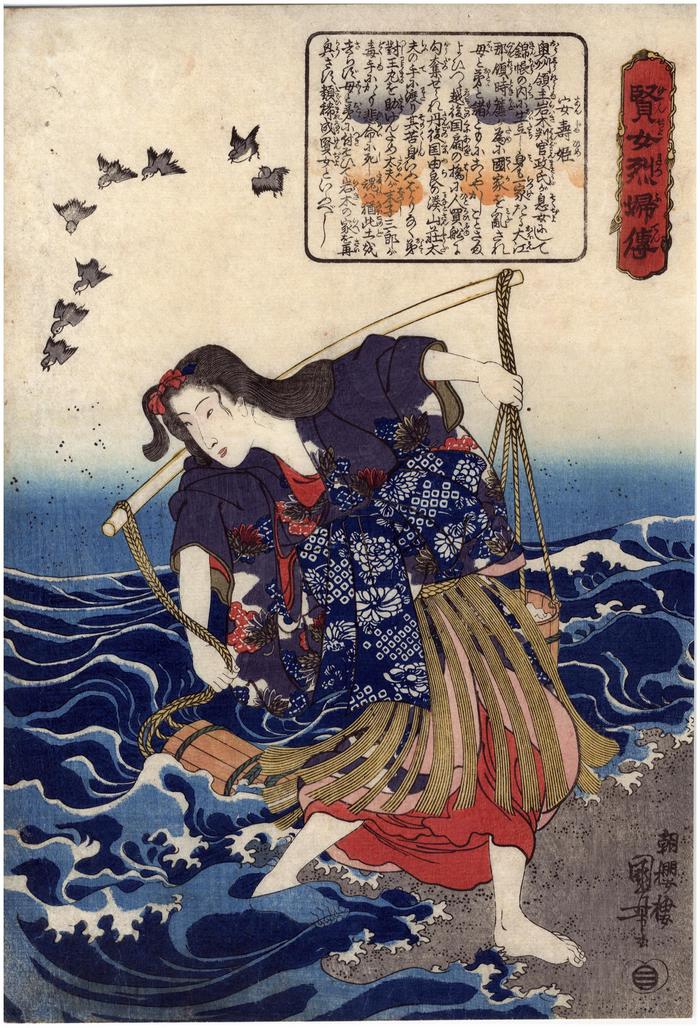Utagawa Kuniyoshi (歌川国芳) (artist 11/15/1797 – 03/05/1861)
Princess Anju (Anju-hime - 安壽姫) from the series The Biographies of the Wise Women and Virtuous Wives (Kenjo Reppu Den - 賢女烈婦傳)
ca 1842
9.8 in x 14.4 in (Overall dimensions) Japanese color woodblock prints
Signed: Chōōrō Kuniyoshi ga
朝櫻樓国芳画
Publisher: Ibaya Senzaburō (Marks 127 - seal 11-001)
British Museum
Tokyo Metropolitan Library - variant with blue and yellow clouds in the cartouche
Tokyo Metropolitan Library - variant with only blue clouds in the cartouche
Hagi Uragami Museum of Art "New regulations concerning colour prints were issued by the shogunate in the sixth month, 1842, as part of the the Tenpō reforms. They included an exhortation for works to be 'composed in accordance with [the values of] loyalty and fidelity, in order to promote virtue among children and women'.... Portraits of famous female exemplars from the past suddenly proliferated. The present series is a prime example....
Each design presents a famous woman from history with a rectangular cartouche containing a short biography. Thirty-one designs are known... Only eleven bear censorship seals, eight the single seal of Muramatsu. This suggests that the series was published around the time of the reforms, perhaps shortly after the regulations had been issued and a new system of censorship by the named city officials (nanushi) was being introduced..."
Quoted from: Kuniyoshi from the Arthur R. Miller Collection by Timothy Clark, p. 132.
Illlustrated with text on page 137: "The viewer is invited to empathise with the lot of beautiful Princess Anju, a high-born young woman ('brought up within the brocade curtain', as the text on the print puts it) who has been sold into slavery. She is shown struggling to scoop seawater into her yoked pail. The richly patterned robe and the contrast between the brilliant red undergarment and Anju's pure white legs give the image an erotic tinge. The straw skirt was typical work-wear for women who collected salt.
The story was a medieval one, much embellished in the Edo-period fiction and drama, and is summarised int he text on the print. Princess Anju is the daughter of Iwaki Hangan Masauji, lord of the northern Mutsu province. With her mother and younger brother, Zushiō-maru ('Tsushiō-maru; on this print), she sets out in search of her father, who has been banished as a result of a fake accusation. In Echigo province they are kidnapped and sold into slavery, entering the service of the evil rich man Sanshō-dayū, who lives at the port of Yura in Tango province. Zushiō-maru escapes and Anju is then tortured to death. Hr restless spirit stays close to her mother and brother as they restore the fortunes of the Iwaki family. 'She was a wise woman of rare calibre', the text concludes."
*****
The Lyon Collection has at least four other prints from this series.
Ibaya Senzaburō (伊場屋仙三郎) (publisher)
beautiful woman picture (bijin-ga - 美人画) (genre)
